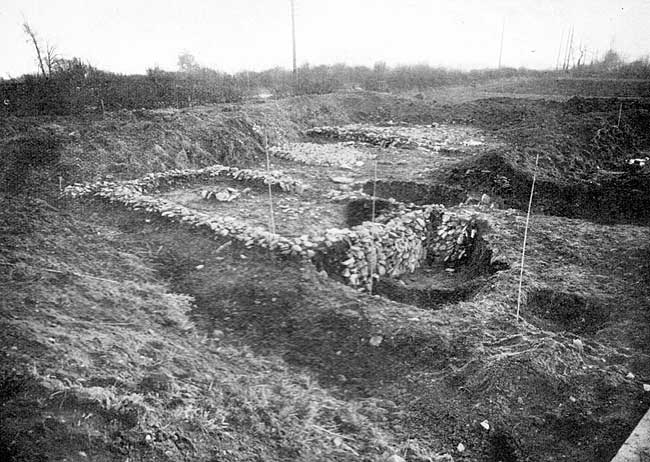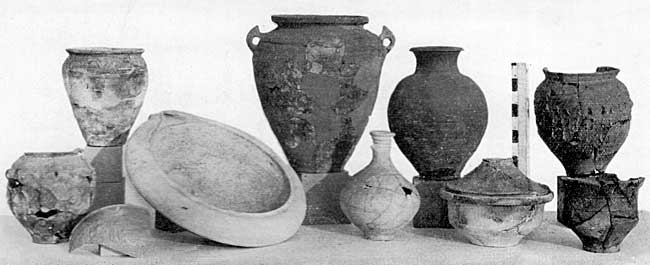For about 50 or 60 years MARGIDUNUM was a military station of some importance and the imported Gaulish red-glazed ware, the so-called "Samian" or Terra Sigillata, is more abundant during this period than afterwards. One of the earliest fragments shows such a well-modelled head of a Silenus that it may indeed be Arretine. It is part of a thin-walled crater, and none of the Gaulish Sigillata can show equal technique in rendering the human face. A separate report, however, will be necessary to describe the abundant and varied Sigillata of MARGIDUNUM, but specimens have been found of all periods, from the purely decorative style prevalent in the Claudian period to the style of the Flavian period when figure-subjects in panels were introduced, and so on down to the style of the Antonine period, when the ware had become coarser and figure-types predominated.
In the earliest period of occupation leather tents may have been mainly used, for no systematic series of post-holes of barracks has yet been found in the southern half of the camp, where they might be expected, although a series of post-holes was disclosed on the north side of the main camp-road, which probably belonged to the front of the early Principia. Unfortunately the main part of this headquarters-building is in a field not yet available for excavation.
On the other hand, some interesting cellars of early date have been found to the south of the Via Principalis. In one case steps in the clay led down to the cellar and there was a ridge dividing the floor into two parts. It is possible that these cellars, as in the Augustan camp at Haltern, were originally lined with wood and roofed over by a floor provided with a trapdoor. Such cellars were used as sleeping-quarters in winter, and would no doubt be warm enough, if somewhat stuffy. Pre-Flavian pottery and a coin of Vespasian found in the black earth in these cellars would seem to indicate that they were filled up about the year 80 A.D. (Plate VII.).

PLATE VII. Early cellars and late buildings (of Constantine age).
The ditches of the camp-roads have yielded some very early pottery, e.g., those of the Via Quintana (Plate VIII.): a honey-jar with pointed handles, a large mortarium with the stamp of the potter SECVNDVS (SECVNDVS F), probably imported from Lyons, carinated urns, urns with the so-called "Rustic" decoration of irregular ridges in applied clay, an early jug, etc. An adjoining pit yielded a complete flagon with a piece of Sigillata of the Domitian period (Form 37 in the style of MERCATOR of Banassac in South Gaul).

PLATE VIII. Pottery from ditch of Via Quintana.
